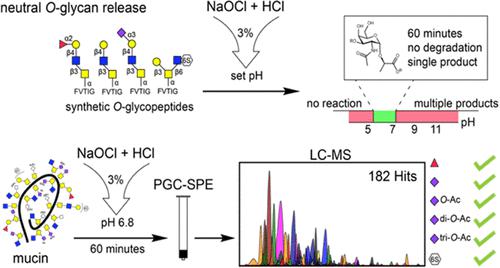当前位置:
X-MOL 学术
›
Anal. Chem.
›
论文详情
Our official English website, www.x-mol.net, welcomes your feedback! (Note: you will need to create a separate account there.)
Oxidative Release of O-Glycans under Neutral Conditions for Analysis of Glycoconjugates Having Base-Sensitive Substituents
Analytical Chemistry ( IF 7.4 ) Pub Date : 2023-06-01 , DOI: 10.1021/acs.analchem.3c00127 Gaël M Vos 1 , Julia Weber 1 , Igor R Sweet 1 , Kevin C Hooijschuur 1 , Javier Sastre Toraño 1 , Geert-Jan Boons 1, 2
Analytical Chemistry ( IF 7.4 ) Pub Date : 2023-06-01 , DOI: 10.1021/acs.analchem.3c00127 Gaël M Vos 1 , Julia Weber 1 , Igor R Sweet 1 , Kevin C Hooijschuur 1 , Javier Sastre Toraño 1 , Geert-Jan Boons 1, 2
Affiliation

|
Protein O-glycosylation is one of the most diverse post-translational modifications. A critical step in the analysis of O-glycomes is the release of glycans from glycoconjugates. Current release methods rely mainly on β-elimination, which can result in peeling reactions and loss of base-sensitive functionalities leading to misidentification of glycans. To address this challenge, well-defined synthetic glycopeptides were used to establish a robust workflow for the oxidative release of O-glycans suitable for glycomics. Treatment of O-glycopeptides with neutralized hypochlorite resulted in the selective formation of lactic/glycolic acid glycosides, thereby retaining unique information of the parent amino acid (serine/threonine) that is lost by β-elimination. It locks the glycan in a closed ring configuration, thereby preventing peeling, and furthermore, the carboxylate of the anomeric tag promotes ionization in negative ion mode mass spectrometry, thereby increasing signal intensities. Labile modifications such as sialic acids, sulfates, and acetyl esters are maintained during the release procedure. The promise of the approach was demonstrated by the analysis of O-glycans from bovine submaxillary mucin, which identified mono- and di-O-acetylated sialoglycans as well as previously undetected tri-O-acetylated and sulfated glycans. The use of well-defined glycopeptide standards made it also possible to identify reaction intermediates, which in turn allowed us to postulate a reaction mechanism for oxidative O-glycan release under neutral conditions.
中文翻译:

O-聚糖在中性条件下的氧化释放,用于分析具有碱敏感取代基的糖缀合物
蛋白O糖基化是最多样化的翻译后修饰之一。O-糖分析的一个关键步骤是从糖缀合物中释放聚糖。目前的释放方法主要依赖于 β-消除,这会导致剥离反应和碱敏感功能的丧失,从而导致聚糖的错误识别。为了应对这一挑战,明确定义的合成糖肽被用于建立适用于糖组学的O-聚糖氧化释放的稳健工作流程。O的处理-具有中和次氯酸盐的糖肽导致乳酸/乙醇酸糖苷的选择性形成,从而保留因 β- 消除而丢失的母体氨基酸(丝氨酸/苏氨酸)的独特信息。它将聚糖锁定在闭环结构中,从而防止剥离,此外,异头标记的羧酸盐促进负离子模式质谱法中的电离,从而增加信号强度。在释放过程中保持不稳定的修饰,如唾液酸、硫酸盐和乙酰酯。通过分析来自牛颌下粘蛋白的O-聚糖证明了该方法的前景,该分析鉴定了单-和双-O-乙酰化唾液酸聚糖以及以前未检测到的三-O-乙酰化和硫酸化聚糖。使用定义明确的糖肽标准品还可以鉴定反应中间体,这反过来又使我们能够假设在中性条件下氧化O-聚糖释放的反应机制。
更新日期:2023-06-01
中文翻译:

O-聚糖在中性条件下的氧化释放,用于分析具有碱敏感取代基的糖缀合物
蛋白O糖基化是最多样化的翻译后修饰之一。O-糖分析的一个关键步骤是从糖缀合物中释放聚糖。目前的释放方法主要依赖于 β-消除,这会导致剥离反应和碱敏感功能的丧失,从而导致聚糖的错误识别。为了应对这一挑战,明确定义的合成糖肽被用于建立适用于糖组学的O-聚糖氧化释放的稳健工作流程。O的处理-具有中和次氯酸盐的糖肽导致乳酸/乙醇酸糖苷的选择性形成,从而保留因 β- 消除而丢失的母体氨基酸(丝氨酸/苏氨酸)的独特信息。它将聚糖锁定在闭环结构中,从而防止剥离,此外,异头标记的羧酸盐促进负离子模式质谱法中的电离,从而增加信号强度。在释放过程中保持不稳定的修饰,如唾液酸、硫酸盐和乙酰酯。通过分析来自牛颌下粘蛋白的O-聚糖证明了该方法的前景,该分析鉴定了单-和双-O-乙酰化唾液酸聚糖以及以前未检测到的三-O-乙酰化和硫酸化聚糖。使用定义明确的糖肽标准品还可以鉴定反应中间体,这反过来又使我们能够假设在中性条件下氧化O-聚糖释放的反应机制。


























 京公网安备 11010802027423号
京公网安备 11010802027423号